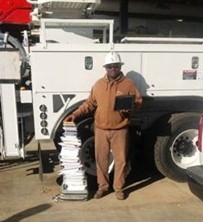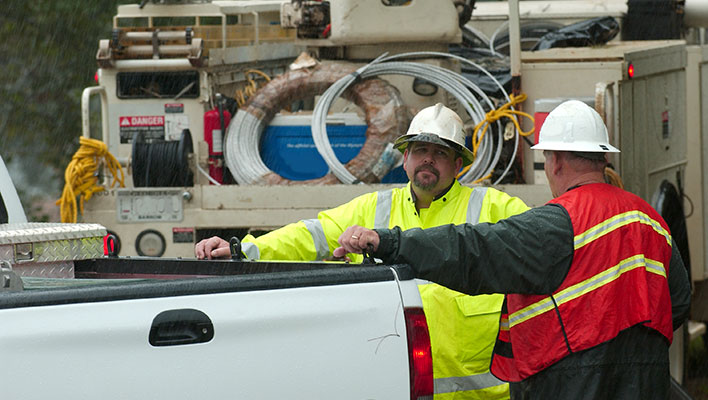Chris McClain is engineering supervisor at Southern Company and is an advocate for helping the electric transmission and distribution industry advance power restoration by leveraging technology to seamlessly manage damage assessment and repair. Bringing insights from the front lines of digital utility transformation, his blog series walks readers through the journey from managing mountains of paper feeder maps to mobile workforce management and power restoration in one of the country’s frequent storm hotspots.
Several years ago, one of our line workers gathered up all the paper-based references that he and his coworkers carry on their trucks that are required and/or necessary for their daily work (construction manuals, safety procedures, switching documents, policies, map books, feeder maps, guidelines, etc.). He neatly stacked all those three-ring binders, spiral-bound books, and folders up on the ground and stood next to them. The stack was waist high. Someone snapped a photo of him standing there with an iPad in his left hand as a good-natured way of showing what’s possible to achieve if we’ll simply give the effort.

Those static documents are all out of date the day after their printed – in some cases before they even land in the binders their being printed for. And there are/were thousands of copies having to be printed, bound, shipped, inserted, replaced, and updated all over our system. With a mobile technology initiative and a little dedicated effort, up-to-date documents can be easily accessed and referenced – and even searchable! No more trying to remember or figure out that a certain switching procedure is in section 21.3 on page 107. Just type what you’re looking for and go.
Today, the paper is gone, replaced by a handful of apps on our field workers iPads, laptops, and phones. When it comes to storm restoration, there’s a single app (synchronized with our GIS daily) that provides a complete street level view of circuits and detailed assets on our system. Combined with an interface to our ADMS, it also helps create clear situational awareness during storm restoration with a complete picture of outages, assignments for both native and non-native crews, and damage assessments in real time. Getting from the piles of paper to the powerful simplicity of the mobile workforce management solution we use today was a digital transformation journey that’s been the basis for this blog series.
In this final post I want to talk about “the prize,” i.e., what the big payoff is in terms of helping crews take the best next step out in the field as we wrap up what I’m calling the 5 essential skills to effective mobile workforce management:
1. Eliminate the cost and risk of paper data that is instantly out of date once printed (e.g., circuit diagrams).
2. Foster digital transformation in the line department, find early, small wins then scale big.
3. Force multiply digital utility transformation by partnering with a vendor to co-own mobile workforce management success.
4. Ensure solutions are securely inclusive of the large pool of mutual assistance crews your team relies on.
5. Empower crews with greater optionality to safely find new solutions for damage assessment and repair.
Optionality is a term borrowed from investors that I think applies well to decision-making during damage assessment and repair operations. It is the ability to choose from a range of possible options or courses of action in a given situation. It’s about flexibility and bolstering confidence to make the best decision.
In the field, optionality should always be centered around safety even as we use mobile workforce management technology to accelerate power restoration. With better situational awareness comes better optionality, giving crews the reliable information needed to make the best next step. This means knowing when to confidently approach an asset or knowing when to step back and verify necessary conditions are met.
ARCOS Mobile Workbench drives clear situational awareness by synching with our most current GIS feeder data and enabling field workers to see the nearest upstream and downstream devices and equipment under which they are working. As they begin to assess damage or perform repair work, they’ll have up-to-date visual information about all the devices and equipment associated with their circuit right at their fingertips. Associated attributes like fuse types and sizes, device ratings, pole heights and classes, conductor specifications, etc. are all available. Symbols and color coding quickly show crews critical system details (e.g., damaged assets, tree conditions, oil spills requiring environmental cleanup). General notes can even be added to make other users aware of other potentially important information like access points, security threat warnings, or even aggressive dogs.
Driving better decision-making during storm restoration is also about eliminating distraction and extra steps for crews. There’s tremendous power in context, which can minimize the number of steps damage assessment teams take to do their job. A mobile workforce management solution like Mobile Workbench understands where users and system assets are located at all times, automatically bringing up the right forms based on type of assetAnd because of precise GIS positioning, Mobile Workbench can automatically zoom to a crew’s location and declutter the interface of information displayed based on their location and zoom level.
If enough resources are available, mobile workforce management technology allows us to divide up a circuit for damage assessment, enabling everyone to see assessment information collected by different teams in real time. On the repair side, a line worker needing to load up materials can lasso an area that’s been assessed on the map and get a quick summary of major materials needed (poles, transformers, devices, conductors, etc.) by size and rating. This allows them to quickly and efficiently load the materials they need and get rolling.
Finally, optionality opens up further paths to efficiency even as restoration efforts are winding down. Instead of paying valuable resources to sit idle waiting on release, we’ve identified ways to take advantage of their presence by performing feeder sweeps looking for partially damaged assets that may have been missed and could cause safety and/or reliability issues down the road. This level of optionality truly helps us get the lights back on safer and more efficiently than ever before by providing situational awareness and confidence to those in the field as well as those coordinating the efforts.
Thank you for reading my blogs. Hopefully, you found a few strategies and insights from our digital transformation journey that your team can incorporate into storm restoration, damage assessment, and repair. I welcome your feedback and your own insights. Please reach out if you’re on LinkedIn – I’m always open to connecting and talking shop with the power delivery community.
Did you enjoy Chris’s blog? Check out his previous post: 5 Keys to Advance Power Restoration: Securely Orchestrating Mutual Assistance




